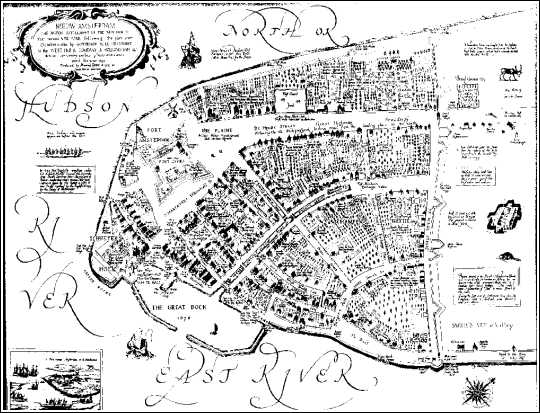
How bad the situation on Manhattan really was is also indicated by the fact that the ship on which Kieft had arrived, Harinck, was loaded with provisions which apparently could not be had in the colony. Among these were forty casks of beef, twenty casks of pork, eight tubs of butter, 1854 pounds of cheese, 2295 pounds hard bread, 360 schepels of barley and 180 schepels of white peas.note Finding no cattle on Manhattan, Kieft managed to get new cattle from the Holland. In the summer of 1639 the ship Brant van Troyen (Fire of Troy) from Hoorn, a private ship commanded by Jochem Pietersen Kuyter, arrived with cattle for the Company. David Pietersz de Vries, the famous captain, patroon, and adventurer who was at New Amsterdam at the time, exclaimed when seeing this ship full of animals at the roadstead, "that there may have come one hundred or three hundred families with farmers".note To guarantee a minimum of grain and dairy produce, Kieft decided to lease the cows and horses of the Brant van Troyen on the condition that for each horse annually had to be paid fifteen schepels of wheat or "hard corn," and for each cow twenty-five pounds of butter. Apart from this, there was the well-known condition of the half-increase. On these conditions seventeen cows and nine horses of the Brant van Troyen were leased to a number of private individuals.note On the same conditions, four horses, arrived from Curacao with the ship Neptune, were leased.note

In 1641, another transport of Dutch cattle to New Netherland took place when the Coninck David was sent with cows and other goods to the North River, Manhattan and Staten Island on the orders of Meijnert Meijnertsz van Keeren.note
The lack of cattle and horses on Manhattan was only part
of the trouble. We have already seen the special provision in
the new lease contracts about the tilling of the land. As a
result of a development in which farmers paid less and less
attention to this, the Company in the 1630s had become
completely dependent on the grain surplus of the patroonship of
Rensselaerswijck on the upper Hudson. Comparatively large
quantities of grain were delivered to the Company by Van
Rensselaers tenants in 1635, 1638, 1640-1644, and 1647, and
probably most of the years in-between.note When a crop failed in Rensselaerswijck, as in 1639, this had severe consequences
on Manhattan.note
| Grain in schepels, delivered by the patroonship of | |
|---|---|
| Rensselaerswijck to the West India Company, 1638-1643 | |
| Year: | Schepels: |
| 1638 | 914 |
| 1639 | 526 |
| 1640 | 323 |
| 1641 | 666 |
| 1642 | 1668 |
| 1643 | 724 |
Illegally, the tenants of Van Rensselaer exported their grain to Manhattan in apparently large quantities at prices below those officially set by the patroon. Time and again the patroon complained about the smuggling by his subordinates.note
*** < previous * next > ***